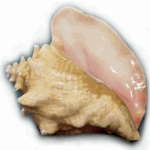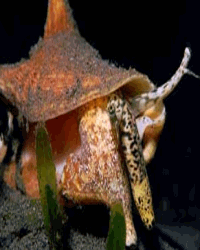Conch Shells
The True Queen Of The
Florida Keys

Quite simply the word Conch means “Florida Keys.”
Well it doesn’t actually mean Florida Keys (It actually means “Shell” from a Greek word) but it SHOULD mean Florida Keys, as it is such a symbol of the string of tropical islands stretching away into the waters from the mainland of America.
If you want to really impress your friends with your in-depth knowledge of the Latin names of molluscs, then you can tell them with confidence that the official name is "Strombus gigas" which is the latin equivalent for "giant spiral shell".
(Note to reader: I actually haven't found anyone that is impressed with this fact, but you might do better than I do!!)
From the early days of its history, and fossils found show that it has been around for sixty five million years, and they keep on making an appearance whether it is as a succulent food supply, a music instrument, a tool, jewellery or even a weapon of choice.
The natives of the Florida keys for over 3000 years have put the snail to great use, and it’s not hard to see why, as it was plentiful and easy to get hold off.
It’s a bit harder to find these shells nowadays, but you can still do it if you try hard enough as anyone with a snorkel or a bit of diving equipment, or just the ability to hold your breath for a long time should be able to get one.

In the waters that surround the Florida Keys there a lots of shallow sandy areas covered with turtle grass and that is where these things like to live and feed.
They lay on the sandy surface and with their shell lightly coloured, they blend in perfectly to sit and wait as a prey make the mistake of coming past.
The problem now though, is although you can find them as mentioned above, the state of Florida have set rules about their removal from their waters, as quite frankly they were over harvested terribly and were looking at becoming a thing of the past.
So how can you get one, so you can make a lovely plate of original conch fritters?
By law under Florida Regulations.
"It is not illegal for any person to obtain, or keep queen conch shells from the waters or lands of the State of Florida, as long as the removed shells do not contain a live animal at the time.
Also the snail must not be mutilated, removed from its protective shell, or killed before taking the shell.
So if you find one that's empty its ok to take, but if you do anything to the animal inside then you are in trouble.
The law also states that:
"If the hole in the shell is larger than 1/16 inch in diameter through its spire this shall constitute a violation of this chapter."
Now that is an interesting rule.
It kind of makes sense if you are protecting the animals, that you can’t just take them away whenever you want, but you may be wondering what the hole bit is all about?
The reason for the mentioning of the hole in the shell, is because the mollusc that live within the shell, is unlikely to pop its head out and say hello just because you look attractive.
To be honest I’m not sure what a snail considers to be attractive , but I guarantee it won’t be you or me.
So they create a fantastically powerful vacuum to stay where they are, and most importantly not being dragged out of the shell by anyone who wants a quick fishy lunch.
And the best way of reducing a vacuum, is by making a hole to release the pressure.
And that is what the law understands and will look for.
So the best thing to do if you find one is make sure it hasn’t been tampered with, or that Mr.Snail isn’t still in residence.
If you do that, then you can’t be in trouble with the authorities and you will have a lovely Queen shell to have on your shelf or desk at home.
Did you know that the harvesting of the snails in Florida Keys waters is illegal?
So in order for our fishmarkets, and fish restaurants to offer such things as fritters they have to buy the snails from the Turks and Caicos islands.
Strange but true!
Inline with the facts above, here is a great video looking at the lifecycle of the conch.
Although these conch are from the bahamas, it provides a wonderful look at the groth patterns, sexual habits and other bits and bobss, that will make your research into the conch as thorough as possible.
Breeding And Mating Facts
The Queen will usually find a mate and do the business in the shallows, normally around the sandy areas that sit behind the coral reefs.
Once it has all happened, the female starts laying eggs, and its quite a job as she produces about half a million that provide the protection around the embryos.
Then about four or five days later the embryos will breakout of the eggs and make their way up the waters surface.
As with most animals making their way through the different stages of their lives, they are not called at this stage what they will be known as adults i.e Conchs.
Instead they are called veligers, and spend about three weeks floating around in the ocean.
Later, when the animal is really no more than the size of a grain of sand, they stop being able to swim and drop to the bottom of the ocean.
By the time this happens, the snail have already grown a minuscule see through shell, which if you are into these type of things is called "protoconch" and has both a mouth and a foot.
They reach a shell length of close to 3 inches after 1 year and 5 inches after 2 years.
Unfortunately, for these tiny creatures not many of them out of the 500,000 embryos get to reach this stage.
Once three years have passed the mollusc is finally classed as an adult and weighs around about two pounds and measures close to seven or eight inches.
But it doesn't stop growing and will keep on getting larger by the tune of three inches per year, although this only happens when the shell is in its growing stage.
The average life span is about 6 to 10 years.
Like This Page?
New! Comments
Have Your Say About What You've Just Read!